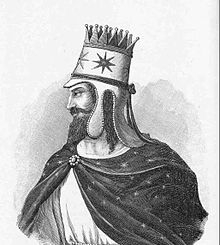Artaxias I
Thursday, April 8, 2021
Artaxias I was the founder of the Artaxiad dynasty of Armenia, ruling from 189 BC to 160 BC. He was succeeded by his son Artavasdes I.
According to the Greek geographer Strabo, Artaxias and Zariadres were Macedonian generals of the Seleucid king Antiochus III the Great (r. 222 – 187 BC). He adds that after Antiochus III's defeat by the Romans in 188 BC, the two generals established themselves a kingdom in Greater Armenia. However, this statement has been dismissed by the recent discovery of boundary stones with Aramaic engravings in Armenia, which mentions Artaxias' proclamation of being "the son of Zareh (Zariadres)" and an "Eruandid (Orontid) king".
The ending of -akān in the engravings, originally used in Old Persian, was extensively used in the Parthian ostraca from Nisa and in later Armenian texts. Anahit Perikhanian thus confirms that both Artaxias and Zariadres, "far from being Macedonians, belonged in fact to the earlier native dynasty, albeit probably to collateral branches, and that the Eruandids, or Artaxiad/Artašēsids as they came to be known, with their Iranian antecedents, continued to rule Armenia as before." In the same manner of that of the monarchs of Pontus and Cappadocia, the Artaxiads stuck mainly to the royal traditions used by the former Achaemenid Empire. At the same time Greek influence was starting to advance in the country.
Artaxias and Zariadres united their armies to expand their dominions; the kingdom of Artaxias, originally centered around the middle of the Araxes river, expanded into Iberian land, and especially the territory of Media Atropatene, which lost its territories at the Caspian Sea and the districts of Syunik and Vaspurakan. Meanwhile, Zariadres conquered Acilisene and Taron. The conquered peoples of the territories likewise also spoke Armenian, however imperial Aramaic (with a largely strong amalgamation of Persian words) was still the language of the government and the court, a practice derived from the Achaemenid Empire. According to the 5th-century CE Armenian historian Movses Khorenatsi, Artaxias ordered the delimitation of villages and farmland, which has been confirmed by archaeological sites in Armenia. Artaxias used many epithets, one of them being the unidentified Persian word of ʾxšhsrt. Artaxias founded the city of Artaxata on the left side of the Araxes river, which would serve as the capital and seat of the Armenian monarchy until the 2nd-century CE. It is unlikely that the former Carthaginian commander Hannibal took refuge at the Armenian court and played a role in the establishment of the city. In 165/4 BC, Artaxias suffered a defeat to the forces of the Seleucid king Antiochus IV Epiphanes (r. 175 – 164 BC), who had him captured. Nevertheless, in 161/0 BC, Artaxias managed to help the satrap of Media, Timarchus, who rebelled against Seleucid rule. Artaxias died in 160 BC, and was succeeded by his son Artavasdes I.





